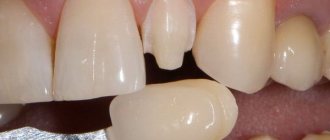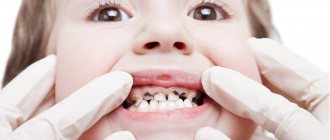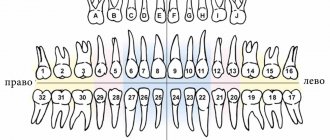Author of the article: Goldstein Maria Anatolyevna
Doctor-expert
Specialization: Dentist-therapist
Total work experience: since 2008
Reading time 7-8 minutes
CONTENTS:
- About tooth enamel
Compound
- Functions
- Diseases
- Why is tooth enamel damaged?
- Indications for strengthening tooth enamel
- How to restore tooth enamel in dentistry
Fluoridation
- Remineralization
- Implantation
- How to strengthen teeth enamel at home
Proper diet
- Folk remedies
- Special means
Enamel is the outer shell of the tooth, which bears the heaviest load (chewing). She is the first to take on the “blows” of active substances contained in food and drinks. In addition, every day, throughout a person’s life, it is the enamel that is subject to friction while chewing food. It is not surprising that over time the question may arise: how to strengthen tooth enamel and what will be required for this? To get a complete answer, you need to learn more about all the features and recovery options.
About tooth enamel
Research shows that enamel is the hardest tissue in the human body. It does not have the ability to regenerate, that is, after destruction it does not recover on its own. Most often, to solve problems with its destruction, the help of dentists is required, although effective resuscitation methods can be used at home.
Compound
The composition of tooth enamel includes the following substances:
- inorganic (96.5%): calcium phosphate;
- magnesium phosphate;
- calcium carbonate.
- water;
It is worth noting that the enamel of temporary (baby) teeth is less mineralized, so their thickness is half as large (they are more susceptible to caries).
Functions
Enamel covers the entire surface of the tooth crown and protects its hard part (dentin) from damaging factors. Within one crown, the thickness of the enamel word varies:
- thinner - on the cutting edges;
- thicker - on the tubercles of the occlusal surfaces (from the tops of the tubercles to the deep part of the fissure).
As long as the enamel performs its basic functions, a person does not feel discomfort when consuming hot/cold, as well as sweet drinks and food. The appearance of sensitivity to citrus fruits and other products indicates a clear problem with the enamel layer, which needs to be restored and/or strengthened.
You might be interested in:
Restoring tooth enamel
Veneers
Diseases
The most common diseases associated with enamel are:
- erosion;
- demineralization.
Despite the fact that only a few diseases can be identified, the consequences of their untimely treatment can be much greater.
Erosion
The main cause of erosion is:
- regular consumption of foods and drinks containing large amounts of sugar, caffeine and acid;
- bruxism (involuntary grinding of teeth at night);
- taking certain medications.
Signs that you have enamel erosion include factors such as sensitivity to hot/cold, brittle teeth (chips and cracks), and discoloration. This process of destruction does not stop or slow down on its own. To restore, strengthen and preserve teeth, you will have to go to the dentist.
Demineralization
Strictly speaking, demineralization is not so much a disease as a process in which the enamel loses essential beneficial minerals (mostly calcium) - the very components on which its strength and integrity depend. The main causes of demineralization:
- poor nutrition in which the basis of the diet is carbohydrates (they are the main breeding ground for bacteria that destroy enamel);
- insufficient and irregular oral hygiene (this results in the proliferation of bacteria that produce acid, which makes tooth enamel loose).
At the first stages, demineralization is imperceptible. It becomes noticeable after whitish spots appear on the teeth, indicating the beginning of caries. At this stage, it is still possible to prevent serious consequences, for example, by saturating the enamel with minerals to strengthen it and increase its resistance to acids.
Write a comment
Maria
January 26, 2015 at 1:40 p.m.
I think this is a useful and necessary article. I know that my teeth enamel is partially destroyed, and this is bad. I can’t normally eat hot food or, for example, hard apples or any other fruits, because it immediately hurts me, which naturally causes discomfort. I tried to get rid of this problem using folk remedies, to be honest, I tried a lot! I chose the most effective ones for myself: changing my diet (I stopped eating all kinds of “nasty” things, that’s all fast food, then I stopped cracking nuts with my teeth (wasn’t I stupid?), I started buying toothpaste that does not contain fluoride and rinsed for 10 days oral cavity with a weak solution of soda! There is an effect, which means the article is important, necessary and informational! Thank you)
Aniriya
May 23, 2015 at 6:19 am
In nature, everything moves and changes. Some things are built and some things are destroyed. If it was not possible to preserve the tooth enamel in acceptable integrity, it is necessary to find a way to restore the damaged areas. It’s very good when experts can suggest and advise something. The article is very useful, thank you. We can only follow the recommendations.
Novel
July 27, 2021 at 8:12 am
I encountered this problem about two years ago. At first I started self-medicating, I haven’t liked going to the dentist since childhood, I rinsed with a soda solution, brushed my teeth with activated charcoal added to the paste, nothing really helped. So I decided to go to the doctor. I was prescribed fluoridation, and within a few sessions my tooth enamel returned to normal. So I advise everyone not to rely too much on traditional medicine, but to immediately consult a specialist.
Oleg
October 15, 2021 at 07:30 pm
Thank you very much for the article, especially for the folk methods. This is a very painful problem for me. I literally scoured the entire Internet in search of cheap ways, since finances do not allow me to go to doctors a lot. So, the method described in this article really helps, unlike those that I found before, I tested it on myself, literally in a month my teeth became better.
Galina
November 3, 2021 at 7:43 pm
After visiting the preventative office, the dentist discharged Rox and gave her mouth guards made of some strange material, into which she poured her professional product after the procedure. She told me to fill each tray with gel, put it on and keep it on for a few minutes. This is necessary to prevent white caries at the necks of teeth. She also ordered me to thoroughly clean these places. I did this for a month. It is impossible to keep trays with gel in your mouth, drool flows and the gel along with them, and the result is 0. I will not buy this gel again.
Sanya
November 7, 2021 at 01:32 pm
I have been using Rox gel for a long time, according to the scheme: I brush my teeth every day in the morning and evening after regular brushing for 1 month. Then a break of 3 months, during which I do only 1 such procedure once a week after thorough brushing of my teeth with an electric brush. Result: cervical caries in the spot stage is gone. Conclusion: you need to use a rocks glass correctly for it to be effective. The instructions give incorrect instructions; it should not be rubbed in, but foamed with a brush.
Zhenya
November 7, 2021 at 7:16 pm
Splat Biocalcium paste helps well with thinning enamel; it seems that it is not forbidden to use it every day all the time. Teeth really become stronger and less sensitive. But Colgate does not give any effect, the usual budget paste is purely for adding freshness and cleaning out food residues.
Why is tooth enamel damaged?
Not only diseases, but also other reasons can lead to damage. To understand how to strengthen tooth enamel, you must first find the root cause of its destruction. It could be:
- poor heredity (if cases of thinned enamel are noticed in the family, there is a high risk of this feature manifesting itself in the offspring).
- uneven load, which leads to gradual wear of the teeth (for example, due to malocclusion);
- various gastrointestinal diseases (those that do not allow the full absorption of nutrients);
- thyroid diseases;
- diabetes;
- incorrectly selected hygiene products (paste and brush);
- brushing teeth with excessive pressure;
- altered composition of saliva (for example, due to excessive and regular consumption of products with aggressive composition that can destroy the enamel layer);
- dry mouth due to insufficient saliva (for example, due to the use of certain medications);
- bad habits (in particular, smoking);
- lack of the required amount of vitamins and minerals in the diet.
If the destruction is a consequence of a disease, only a dentist can help cope with the consequences. Non-medical causes can be ruled out on your own, while at the same time strengthening and restoring the enamel at home.
Firming massage
Strengthens loose gums by improving blood flow through massage. Hands must be clean or wear sterile gloves and finger caps. The effect is enhanced by adding pine needle paste, honey or a suitable essential oil.
Grab the jaw with the 1st and 2nd fingers of the hand and massage the loose gums along the jaw in smooth circles for 5–7 minutes, without applying pressure. After the massage, rinse with an antiseptic.
You cannot massage if there is gum bleeding.
Indications for strengthening tooth enamel
The main signs that are a reason to think about how to strengthen tooth enamel are the following:
- Hypersensitivity of teeth
. There is an acute reaction to the temperature of food/drinks, mechanical irritants (for example, when biting an apple, using a brush) and the appearance of painful sensations when eating something sweet, spicy or sour. - Diagnosed caries
. Both in a neglected state and at an early stage. - Destruction of hard tissues
. Visually you can notice chips, crumbling, different sizes of notches and depressions. - Bite abnormalities
. Their appearance will inevitably lead to gradual abrasion, which contributes to the rapid destruction of the enamel layer. - Color change
. Teeth lose their natural shine, and pigment deposits appear (including chalky, brown, black or yellow spots). Also, due to thinning, dark dentin may be visible through the enamel. - Orthodontic treatment
. After installing braces, it is difficult to fully care for your teeth, which can result in problems with the enamel. It is better to take care of strengthening it before installing braces and check the condition of the enamel layer throughout the entire time you wear these orthodontic structures. - Pregnancy and lactation
. At this time, it is necessary to pay special attention to the condition of the teeth so as not to lose them. Timely restoration and strengthening of enamel will protect and maintain a healthy and attractive smile.
Long-term drug treatment of serious diseases (including radiation therapy) can also be a reason for visiting dentists.
Making crowns
Crowns are made from an impression that is taken from the prepared teeth. To obtain this impression, the orthodontist will use a special plastic mass. Based on the impression taken, the laboratory will first make a plaster model of the prosthesis, and then a crown, which will be placed on the tooth.
Modern dental crowns are made from different materials: metal, ceramic, metal-ceramic and zirconium. The timing of the production of the prosthesis will depend on what kind of crown it is decided to place on the tooth. Crowns made of ceramics and metal-ceramics take the longest to produce. So that a person does not have to walk without a tooth during the entire time of making the crowns, a temporary plastic prosthesis is put on the tooth.
IMPORTANT: Temporary plastic crowns help hide a defect in the dentition; a person will not have to be embarrassed by the absence of a tooth and experience stress for this reason. Also, temporary dentures help protect a ground and therefore weakened tooth from the negative effects of environmental factors and bacteria.
How to restore tooth enamel in dentistry
After studying the full clinical picture and, based on an examination of the oral cavity and the condition of the teeth, the dentist will professionally select the optimal treatment method. To obtain the desired result in restoring and strengthening enamel, clinics most often offer one of three options:
- Fluoridation.
- Remineralization.
- Implantation.
The choice of a specific option depends on the condition of the enamel layer, the individual characteristics of the patient and the effectiveness in each specific case.
Fluoridation
It is carried out using fluoride-containing compounds, which the doctor applies after cleaning and preparing the teeth. The method is suitable for restoring the enamel of not only permanent, but also baby teeth. The advantages of the procedure include the following facts:
- helps eliminate hypersensitivity;
- improves barrier properties in relation to aggressive environments;
- is an effective preventative of caries.
Depending on the indications, the dentist performs a simplified procedure (covering only the crown of the tooth) or a complicated procedure (covering the outer and inner parts of the tooth). The recommended frequency of fluoridation is 1-3 times a year.
Remineralization
A procedure that allows you to restore the balance of minerals and thereby strengthen the enamel coating, restoring it. First, professional cleaning of the oral cavity is carried out (including using ultrasonic units). After this, special products enriched with calcium, fluorine and other necessary microelements are applied to the teeth.
Remineralizing therapy, depending on the initial state of tooth enamel, can be a one-time procedure. And sometimes a whole course and 5-10 or more procedures may be needed.
Implantation
The most serious and technically complex method. It consists of implanting an artificial layer onto a natural one in order to restore the integrity of the enamel layer. The organic material used for implantation is as similar as possible to natural material. After application, it reacts with tooth enamel at the cellular level, activating its regeneration.
The result is a strong and reliable layer that perfectly protects the tooth from mechanical damage and destruction under the influence of aggressive environments. A technically complex and expensive operation is fully justified, since in addition to protective functions, it can also restore aesthetic appearance (and this is especially important if the front teeth in the smile area have been affected).
Reviews
We invite readers who have experience in using enamel restoration methods to share their feedback in the comments to the article.
If you find an error, please select a piece of text and press Ctrl+Enter.
Tags tooth enamel
Did you like the article? stay tuned
Previous article
Teeth are crumbling, what to do in such a situation?
Next article
Oral irrigator Waterpik WP-100 E2 Ultra: what it is, advantages, approximate cost
How to strengthen teeth enamel at home
Home restoration of tooth enamel can be combined with a professional one, but it can be carried out more often than dental procedures. An integrated approach is encouraged, which takes into account three main areas:
- The right diet.
- The use of folk remedies.
- Use of special means.
Only in isolated cases can one of the three listed methods be effective. But strict adherence to the recommendations in all areas is guaranteed to lead to the desired result.
Proper diet
In this case, diet is not an entirely correct concept, since strengthening and restoring tooth enamel will require not a temporary change in eating habits, but a permanent one. That is, it is necessary to adjust the diet so that it necessarily and regularly includes foods that help strengthen the enamel layer:
- seafood;
- egg yolk;
- fermented milk products (natural, without added sugar);
- nuts;
- greenery;
- fatty river and sea fish;
- rice and buckwheat;
- fruits (in particular mango and tangerine);
- celery;
- mushrooms;
- legumes (without hot sauce);
- red meat;
- liver.
The listed products are replete with easily digestible microelements (fluorine, calcium, phosphorus) and vitamins (C, D and B6), which naturally can do everything so that you no longer wonder how to strengthen tooth enamel.
Please note that the diet should consist not only of boiled, baked or steamed vegetables, but also raw ones. In their natural form, they help create an alkaline environment in the mouth, which is harmful to cariogenic bacteria.
Folk remedies
When discussing with your dentist how to strengthen your teeth enamel, be prepared for him to offer you some proven and effective traditional methods. For example:
- rinsing
: with a solution of soda (1 tsp per glass of warm water); - propolis solution with the addition of calamus extract (suitable for daily use; effectiveness depends on regularity);
- a decoction of sage, chamomile and oak bark (not only strengthens the enamel, but also restores the microflora of the oral cavity, stopping inflammation of the mucous membrane).
:
- you need to make a solution (4 tablespoons per 1 glass of water) and, using a soft brush, use it for regular brushing of your teeth;
(beeswax or propolis balls) used after meals for:
- normalization of salivation;
It is very important to understand that maximum effectiveness from traditional methods can only be achieved with prevention or with minor (weak) damage to the enamel. More often they are used as an addition to the main treatment prescribed by the dentist.
Special means
Special products that are commercially available can be both a panacea in case of enamel destruction and a drug that will only aggravate the problem. The fact is that none of the special compounds can be used without a doctor’s prescription, since it will not bring the desired effect, but can only harm, not only the teeth, but also health in general.
As prescribed by your dentist, you can use:
- Pastes
: Calcined and fluorinated. Fluoride-enriched pastes are contraindicated if there is inflammation in the oral cavity. - With theobromine. Composition based on cocoa beans. Promotes natural regeneration of hydroxyapatite in enamel.
- With amorphous calcium phosphate. By contacting with saliva and hydroxyapatite, the active substance promotes the formation of a protective barrier on the tooth surface. It protects against exposure to aggressive environments and accelerates the remineralization process.
. Convenient for those cases when it is necessary to apply an antiseptic to the gums and teeth (for a relatively long time). Used for home remineralization. There are several types, for example:
- with active components in the form of calcium and phosphorus ions (penetrate into damaged areas of enamel, filling them and effectively restoring the integrity of the tooth coating)
Knowing how to restore tooth enamel using special means, do not rush to self-medicate. In some cases, formulations with a specific active substance may simply not be suitable for your clinical case. One consultation with a specialist will be enough to find out which paste, cream or gel is best for you.
Use of folk remedies
In addition to the usual home procedures and methods, a number of traditional medicine recipes are available on the Internet that help restore enamel:
- A mixture of beet and garlic juices should be applied to the surface of the teeth for a short time, and then rinsed thoroughly with water.
- Rinse for a week or two with a weak warm solution of soda . One teaspoon per glass. Instead of baking soda, you can use sea salt in the same way.
- To brush your teeth twice a week for one and a half months, use two crushed tablets of activated carbon . Wood ash is suitable as a cleaning agent instead .
- Using the white part of the lemon peel . It should be used to wipe and treat the enamel. However, there is a possibility of aggressive effects of this drug.
It is better to refrain from such experiments and buy specialized remineralizing products (gel and paste). Spent 500 rubles. will help save thousands on the treatment of an advanced problem, aggravated by the influence of dubious folk remedies.
Read also
What is dental restoration
If the aesthetic properties of teeth are lost, a person experiences certain discomfort.
Who is an orthopedic dentist?
Orthopedics in dentistry is a branch of medicine that deals with the restoration of teeth using all modern prosthetic techniques.
Symptoms of a thinning protective shell
It is not difficult to understand that the “guardian” of the integrity of teeth has undergone destructive processes. The following symptoms of thinning tooth enamel will eloquently tell a person about this:
- the outer shell loses its natural transparent shine, becomes dull,
- dark, white or yellow spots or stripes appear on the surface,
- hard foods or brushing begin to pose a problem - discomfort and even pain appear,
- teeth begin to react to the temperature of foods, sour, sweet, spicy, tobacco smoke, and sometimes just frosty winter air.
Dentists distinguish a local form of destruction, when one tooth suffers, and a generalized form, which occurs more often and is accompanied by increased sensitivity of the whole group. Any of the listed symptoms requires a visit to dentistry and restoration of damaged tooth enamel, so that the onset of the pathological process does not result in serious dental problems: caries, pulpitis, periodontitis, tooth loss.
Consequences of abrasion of the outer shell
Thinning of tooth enamel is a rather alarming situation; it threatens the integrity of all elements of the series. When the upper protective layer is damaged under the influence of certain factors, the inner part, the dentin, is exposed. And since this tissue is somewhat softer and more permeable than the hard shell, its destruction will be quite rapid. When the dentin boundaries are open, nothing prevents microbes from quickly penetrating into the pulp and starting the inflammatory process.
The consequence of this is the rapid destruction of bone tissue due to the development of caries, pulpitis or periodontitis. It happens that the ligaments that hold the teeth in the sockets are involved in the inflammatory process. In this case, they will inevitably be lost over time. That's why it's important not to hesitate to see a doctor at the first sign of increased tooth sensitivity, loss of shine, or staining.










